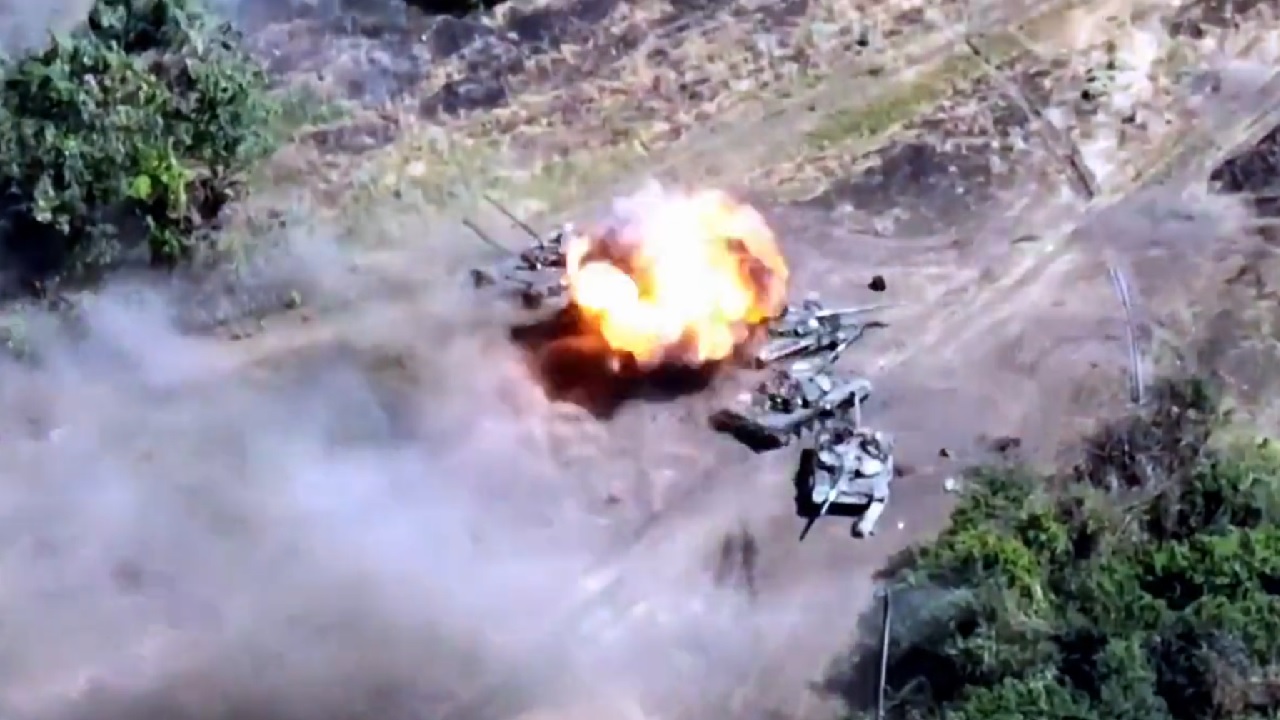It seems like every time you check on the war in Ukraine, you see another Russian tank destroyed in vivid detail, its demise shared on social media videos and in news reports. Just how long can Russia hold out as it loses the tanks in its inventory?
The plan for the Kremlin’s army is simple: Bombard the Ukrainians in the Donbas with artillery, rockets, and missiles. Then carry out maneuver-warfare techniques, using tanks and armored personnel carriers with dismounted infantry to assault the territory that Ukraine holds.
This operational art requires numerous tanks. With armor less available, stalemate is likely to continue, with no real Russian advances, but rather incremental gains that serve to lengthen the war.
Hundreds of Tanks Lost
As of July 18, Russia has lost 237 T-72B3 tanks, hundreds more in other T-72 variants, and 170 T-80s, according to Oryx Intelligence. This adds up to around 800 Russian tanks destroyed – most of them Soviet-era tanks that Moscow upgraded over the years. According to the RAND Corporation and the International Institute for Strategic Studies, Russia had 2,700 tanks before the war, with about 10,000 in storage.
The losses have quickly added up, with some units getting hit repeatedly by Ukrainian soldiers, drones, artillery, and aircraft. Russia’s 4th Guards Tank Division saw 41 of their T-80s destroyed in only two weeks.
To increase firepower and execute their strategy of having infantry dismount from armored personnel carriers to accompany armor, the Russians use battalion tactical groups, or BTGs, as their organizational unit. These groups mix tanks, infantry, and artillery, along with various support vehicles. The battalion tactical groups are showing weakness in Ukraine. More bluntly stated, they are being eaten alive by spirited Ukrainian defenses.
Phillips O’Brien, a professor of strategic studies at St. Andrews University, told the BBC that “[BTGs are] designed to attack quickly with lots of firepower. However, they have very little protection in terms of infantry personnel to escort them and to retaliate if the armored column comes under attack.
“That makes the Russian army like a boxer who has a great right hook and a glass jaw.”
That glass jaw is a glaring problem. Russia’s armored units were supposed to sweep through Ukraine and push the enemy into fearful retreat. To add humiliation to Russia’s losses, the Ukrainians have taken abandoned Russian tanks and turned them into assets of their own. (Oryx believes at least 54 Russian tanks have been abandoned.) They even repair damaged Russian tanks and re-flag them as Ukrainian.
Poor Tactical Start Pays Bad Dividends
One of the reasons for Russia’s difficulties is that early in the war, the Russians utilized vast numbers of tanks in long columns on roads, making them easy pickings for anti-tank missiles and drones. Columns of vehicles can be trapped easily by eliminating armor at the front and rear of a long line. The advance bogs down, and armored vehicles run out of fuel.
Russia has since avoided that practice, but they are still getting ambushed in cities and villages by anti-tank missiles, drones, and artillery. Russia has adjusted tactics – its forces use attack helicopters to fly ahead of tanks and try to sniff out ambushes before they happen. Russia is also making better use of infantry to eliminate as many Ukrainian fighters armed with anti-tank missiles as they can.
Sending in the Clown Tanks
Russian tanks often store ammunition in a carousel below the turret. Incoming missiles can strike the top of the turret and explode the tank rounds inside, creating a huge fireball that blows the turret off the tank. To counteract this, Russian tankers constructed metal cages at the top of their turrets to shield against anti-tank missiles. This did not work, and worse, it kept soldiers from escaping tanks that caught fire.
Russia is starting to take older T-62s out of storage and send them into battle. The T-62 is obsolete, having entered service in 1961. It has an underpowered 115mm gun, and its armor is not up to the challenges of modern warfare against anti-tank guided munitions such as the Javelin and NLAW.
Russia can continue to use its current tactics of mass bombardment by artillery, including rockets and missiles to soften enemy fortifications and eliminate soldiers with anti-tank weapons. Then it can allow infantry to protect the flanks of advancing tanks, and to keep anti-tank gunners at bay. Russia must also use recon drones and attack helicopters to fly out front and report the positions that have anti-tank missiles so artillery can destroy them. It can then add more tanks from storage and have the older models remain in the rear as a reserve force while the modern tanks punch holes in enemy defenses.
This means there will inevitably be more destroyed tanks – maneuver warfare is never perfect. Putin’s armored forces must continue to evolve their tactics with air cover and infantry assaults. They also have to successfully integrate the older tanks that are coming out of storage. Russia can only hope that Ukraine loses the will to fight as its own losses mount.
Now serving as 1945’s Defense and National Security Editor, Brent M. Eastwood, PhD, is the author of Humans, Machines, and Data: Future Trends in Warfare. He is an Emerging Threats expert and former U.S. Army Infantry officer. You can follow him on Twitter @BMEastwood.

